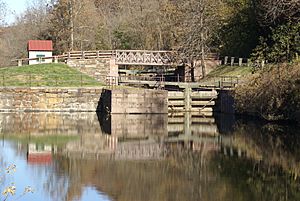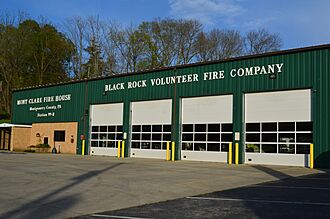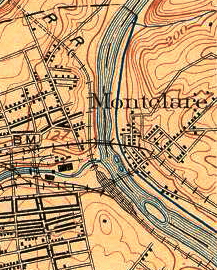Mont Clare, Pennsylvania facts for kids
Quick facts for kids
Mont Clare
formerly Quincyville
|
|
|---|---|

Schuylkill Canal Lock 60 in Mont Clare
|
|
| Etymology: Mont Clare/Clair from poet Bayard Taylor | |
| Country | United States |
| State | Pennsylvania |
| County | Montgomery |
| Township | Upper Providence |
| Population
(2020)
|
|
| • Total | 1,852 |
| Time zone | UTC-5 (Eastern Standard Time) |
| • Summer (DST) | UTC-4 (Eastern Daylight Time) |
| ZIP Code |
19453
|
| Area codes | 484 and 610 |
Mont Clare is a small village located in Upper Providence Township, Montgomery County, Pennsylvania. It sits on the Schuylkill River, directly across from Phoenixville in Chester County. Mont Clare is known for being the site of a historic river crossing called Jacobs' ford. It's also home to the only working lock on the Schuylkill Canal, which is a special waterway for boats. The village was the birthplace of Harry Longabaugh, also known as the Sundance Kid. In 2020, about 1,852 people lived in Mont Clare.
The village was first called Quincyville. Over time, it was also spelled Quinzyville, Mont Clair, and Montclare.
Contents
Mont Clare's Story: A Look Back in Time
Before Europeans arrived, the area where Mont Clare is now was home to Native American tribes. The Unami-speaking Lenni-Lenape tribe had a camp or village here. By 1773, most of these people had moved away.
Early Days: Colonial Times and the Revolutionary War
The land was first claimed by the Duke of York. In 1681, King Charles II gave the land to William Penn. This created the Province of Pennsylvania. The site became part of Penn's Manor of Gilberts and Philadelphia County. In 1729, Providence Township was formed, including the Mont Clare area.
One of the first European settlers was Patrick Gordon. He was the Deputy Governor of Pennsylvania from 1726 until he passed away in 1736.
Later, another Patrick Gordon leased land from William Penn's sons in 1761. This Gordon lived in a cave near where the Mont Clare train station would later be built. He was known for living simply and sometimes taking his neighbors' farm animals.
During the colonial period, the river crossing (ford) brought many travelers through Quincyville. It's believed that Joseph Richardson had an inn here in 1766.
The ford was important during the American Revolutionary War. Both American and British soldiers used it. In 1777, Lord Cornwallis and his British troops crossed the ford. This helped them eventually take Philadelphia. A small American victory happened at Gordon's Cave. A group of British soldiers stopped there to cook a goose and were captured by local militia.
In 1784, Philadelphia County was divided. The village then became part of the new Montgomery County.
On December 3, 1785, about 700 acres (280 ha) of land in Mont Clare were sold. The grandsons of William Penn sold it to Quaker John Jacobs. The first Jacobs family member to live there was Israel Jacobs, who was a colonial Assemblyman and later a Representative.
In 1805, Providence Township was split. The village became part of the newly formed Upper Providence Township.
The Canal Era: Waterways and Bridges
In the 1820s, the "Schuylkill Navigation" canal was built through the village. This brought more trade and visitors. The 3.5-mile (5.6 km) "Oakes Reach" canal started in Mont Clare. It ran past Port Providence and rejoined the river at Oaks. The Black Rock Dam, Lock 60, and a house for the lock operator were built in Mont Clare. Later, part of the canal was filled in. However, residents of Mont Clare and Port Providence made sure the upper part stayed filled with water for fun activities.
In the winter of 1843-1844, Joseph Whitaker helped get a plan approved for the first Mont Clare Bridge. Construction began in the summer of 1844 to replace the old ford. In 1846, Whitaker moved to Quincyville. He built a home and a saw mill there. His home was named Mont Clare (or Montclair). This name was suggested by the poet Bayard Taylor in 1847. This helped set the stage for the village's future name.
By 1859, Quincyville had an inn, a store, a saw mill, a lumberyard, and seventeen houses. There was also a post office, but it closed in 1858.
The post office reopened from 1861 to 1868, but it was called Mont Clare. During the 1870s, the village name slowly changed from Quincyville to Mont Clare.
The Rail Era: Trains and Firefighters
Between 1882 and 1884, the Pennsylvania Schuylkill Valley Railroad built a line with a station in Mont Clare. This train line connected Philadelphia and Reading. The tracks crossed what used to be the front yard of the Mont Clare estate house. The house's driveway was moved to the back. In 1906, an express train derailed in Mont Clare, but luckily no one was hurt. The Mont Clare station closed between 1955 and 1958. The line is now used for freight by Norfolk Southern. There are also plans to bring back passenger rail service to Mont Clare in the future.
In 1886, the Mont Clare Post Office reopened. It was called Montclare from 1895 to 1905. The post office eventually closed near the year 2000. Today, mail for Mont Clare (ZIP Code 19453) is handled by the Phoenixville Post Office.
In 1900, the volunteer Mont Clare Fire Company was started. They were officially recognized in 1910 and celebrated their 100th anniversary in 2010. Besides fighting fires, they also have special teams for water rescues with boats and divers. This is important because Mont Clare is located by the river and canal. In 2012, the company joined with the Oaks Fire Company to form the Black Rock Volunteer Fire Company. They continued to operate from both the Mont Clare and Oaks firehouses for many years.
How Mont Clare Got Its Name
The village slowly changed its name from Quincyville to Mont Clare in the late 1800s. It adopted the name of the large estate owned by a well-known resident. The post office was renamed "Mont Clare" in 1861. Maps from 1871 and 1872 still showed it as Quincyville. However, an 1873 map showed it as Mont Clare. An 1877 map called it "Mt. Clare" but also mentioned "Quincyville or Mont Clare."
Some people thought the railroad named the station "Montclair" after Whitaker's estate, which led to the name change. But the railroad station was built in the 1880s, after the name Mont Clare was already being used. Some old maps even showed both names at the same time. By 1895, maps no longer mentioned Quincyville.
There has been some discussion about how the name should be spelled. In the 1850s, some records used "Quinzyville." Poet Bayard Taylor might have spelled the estate's name Mont Clair. However, Samuel W. Pennypacker, who grew up on the estate, always spelled it Mont Clare. Today, the official spelling is Mont Clare, though Montclare is sometimes seen.
Mont Clare's Location and Nature
Mont Clare is located inside a curve of the Schuylkill River. The river forms the western and southern edges of the village. The village is built around a historic river crossing and a modern bridge. The lower part of Mont Clare is in the river's flood plain, which means it can sometimes flood.
In 1995, the Mont Clare Cliffs and Ravines were recognized as an important natural area. These are steep cliffs and deep valleys along the Schuylkill River. They are formed by hard rocks meeting the river.
Fun Things to Do in Mont Clare
Mont Clare is mostly a quiet place where people live. It has two churches: the Holy Archangel Michael Byzantine Catholic Church and the Otterbein United Methodist Church. You can take a short walk across the bridge to reach downtown Phoenixville. There, you'll find restaurants, pubs, and the historic Colonial Theatre.
Mont Clare is home to Lock 60, which is a fully restored and working lock on the Schuylkill Canal. The lock, its walking path (tow path), the restored lock operator's house, and the surrounding area are all part of a park. This park is cared for by the Schuylkill Canal Association (SCA). It's a great place for outdoor activities. The park has a floating dock in the canal and a launch area on the river. You can also find a portage trail here. This trail connects the canal to the river, creating a 5-mile (8.0 km) loop for canoes and kayaks.
The SCA holds its yearly Canal Day festival in the summer, which is a fun event for everyone. St. Michael's park also hosts the annual local Irish Festival. There's another park, Port Providence Park, located between Mont Clare and Port Providence along the canal. Until 2020, Mont Clare was the end of the Schuylkill River Trail (SRT) coming from Philadelphia. Now, the SRT crosses the Mont Clare Bridge and continues through Phoenixville. There are plans to improve and extend another trail, the Schuylkill East Trail, from Mont Clare. This will make Mont Clare an important meeting point for trails.
Joseph Whitaker's old home, the Mont Clare estate, is still standing today. It's located at the corner of Bridge and Grace Streets. Grace was the name of Joseph's wife. The home is still lived in by Whitaker's family members.
Famous People from Mont Clare
Around 1760, David Todd settled near Mont Clare. His sons, John, Robert, and Levi, became important pioneers. They helped start the city of Lexington, Kentucky. Many of David's family members were still living in the area in 1884. The most famous Todd descendants were Mary Todd Lincoln, who was the wife of U.S. President Abraham Lincoln, and their son, Robert Todd Lincoln.
In 1855, John F. Funk, who would later become a leader and publisher in the Mennonite Church, had his first job teaching in a one-room schoolhouse in Quincyville.
The 23rd Governor of Pennsylvania, Samuel W. Pennypacker, spent his childhood at his grandfather Joseph Whitaker's Mont Clare estate. In 1862, Pennypacker also had his first professional job teaching in a one-room schoolhouse in the village.
Mont Clare is the birthplace of Harry Alonzo Longabaugh, born in 1867. He became known as the Sundance Kid. He was born at 122 Jacobs Street. His mother's family, the Places, were from Mont Clare. Harry A. Place was an alias the Sundance Kid used. His parents and sisters are buried in the nearby Morris Cemetery in Phoenixville.
Between 1882 and 1899, the poet and local historian Christian C. Sanderson grew up living in Mont Clare and nearby Port Providence. He called his home at 205 Jacobs Street "The Little Brick House" in his writings.
In 1916, the Mont Clare estate was lived in by Phoebe Hunter Gilkyson. She was a great-granddaughter of Joseph Whitaker. Mrs. Gilkyson was a well-known writer and social figure. Her poems and stories were published in famous magazines like Harper's and Scribner's. Her son, Terry Gilkyson, was a songwriter and musician. He helped write the popular song Memories Are Made of This and wrote the Oscar-nominated song "The Bare Necessities" from The Jungle Book movie (1967).




